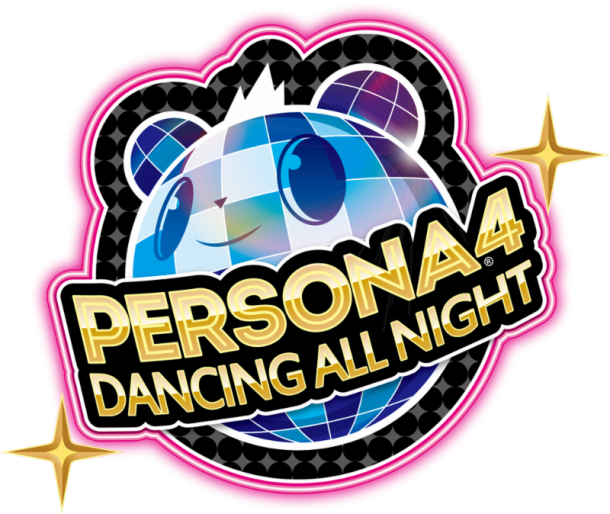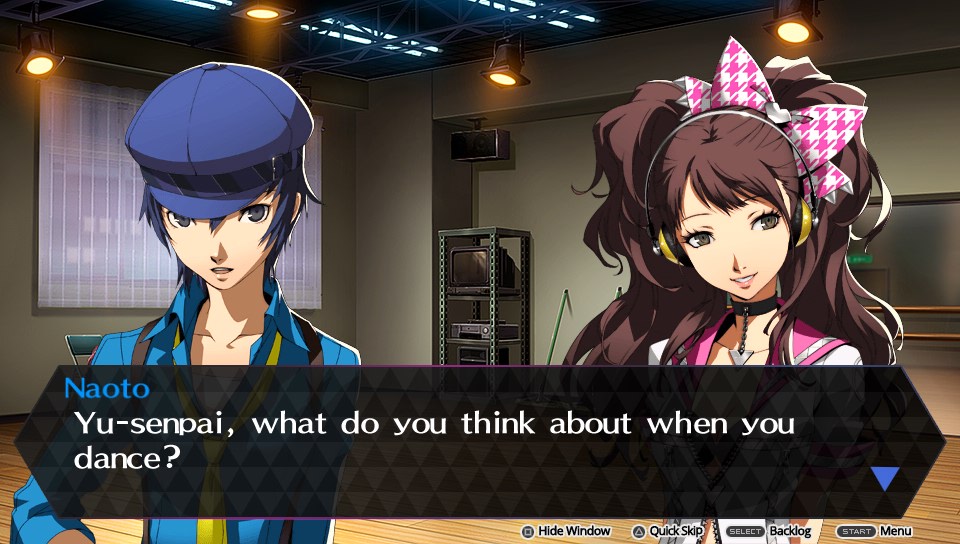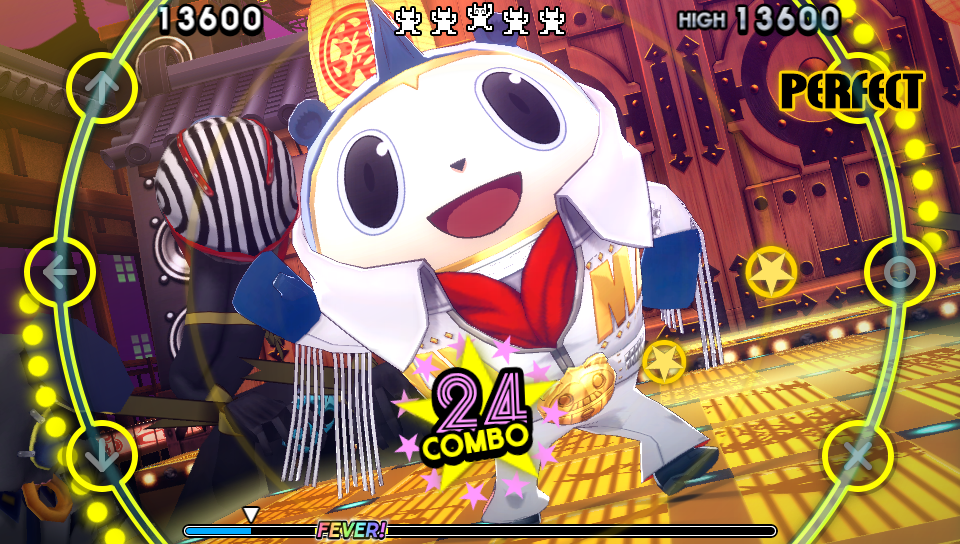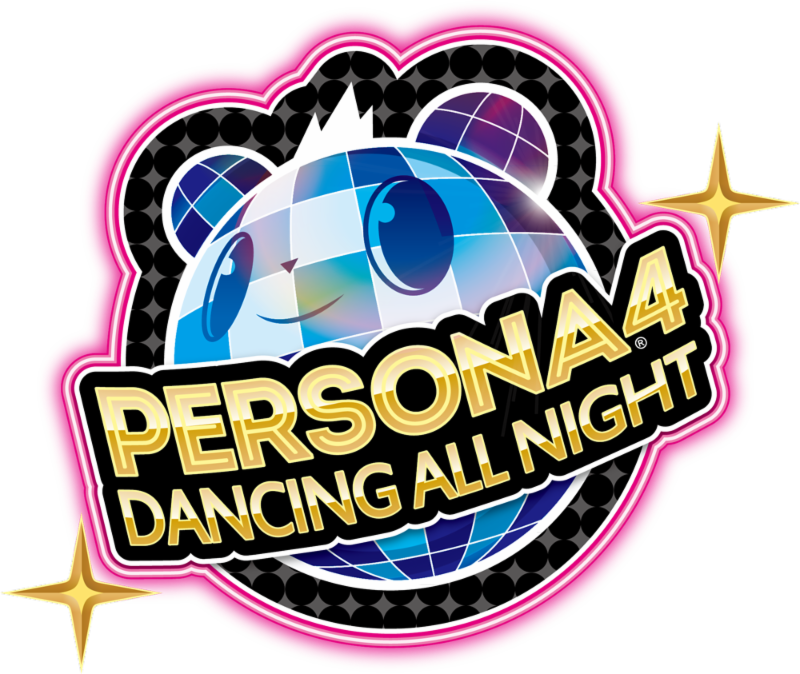
Persona 4 Dancing All Night is like a book with those buttons that play sounds. An anime with the ability to participate in the dance sequences. If this sounds like a bad description it shouldn’t. Dancing All Night is able to take rhythm games and attach them to a series know for it’s storytelling while also tweaking the gameplay away from the established. Fans of the Person 4 series experience are getting a remixed take on what has already been a great legacy, while newcomers are getting an entry point into an ongoing story featuring welcoming gameplay, fun songs, and of course dancing.
Persona 4 Dancing All Night picks up after Persona 4 Arena Ultimax and follows the main cast of Persona 4 in yet another mysterious adventure. But if you haven’t had a chance to play the Persona games in the past, all you really need to know is that the story follows a group of friends involved in a case of mysterious disappearances.The supporting group members of Kanamin’s Kitchen, a Japanese meat-themed idol group, have gone missing and it’s up to you and your group of friends to solve the case. Without going into too much detail, each member is facing an internal conflict that your group, through the power of dance, helps to solve. These individual stories take a look at what it means for a person’s life to be made into a product for consumption and the ludicrously high standards that are put on idols and teenage girls as a whole. These topics are covered maturely and dole out quite a few life lessons without coming off as preachy or dismissive.
The story plays out like a visual novel with a few selectable dialogue choices. Dancing isn’t the focus here, instead it’s used as a way to break up the story, preventing it from just becoming walls of dialogue. This shouldn’t really come as a surprise to fans of the series, but for newcomers this isn’t actually a bad thing. Even on the Story’s hardest difficulty settings, each song is set to easy which should allow just about anyone to make it through. Luckily the story is broken up into chapters so if a player doesn’t want to be locked into thirty minutes of dialogue before playing another song, they can hop out and play free dance at any time.

Dancing All Night features 2 modes. Story, which follows the group’s adventure, and Free Dance, where players can choose from a list of songs to hop right into the action. Although each song’s main dancer is always the same, players can choose a backup dancer and change the outfits of both dancers with costumes unlocked by purchasing them at the in-game store with credits earned through playing both modes. Gameplay follows traditional rhythm game controls, hit the correct note in time with when the note passes through that lane’s marked area. But unlike the more established rhythm game structure of having notes descend from the top of the screen, notes start at the middle of the screen and flow outward. Each side of the screen has three note lanes the players is responsible for, with an occasional loop that fills both sides. These loops are optional, meaning they won’t hurt a score if missed, but they can make combos grow larger and are needed if a player hopes to achieve a perfect score on a song. Notes don’t always fall on a musical or visual cue like most players will be used to. This may be jarring for some at first, but it makes sense since the game is about dancing and interpretation of the song rather than performing the music. Previous rhythm game experience will help, but there is definitely a learning curve when it comes to where your eyes need to be focused on the screen. Some songs on higher difficulties feature tricky notes that are almost hiding inside of other notes. After playing the songs through a few times players will know when to expect them, but even if they never learn to play them correctly completion of higher difficulties won’t ever hinder experiencing everything the game has to offer.

The in-game store doesn’t just feature costumes and accessories, but also different items that can affect gameplay. These could range from making money easier to earn or making it easier to string combos together. Some items may help in one aspect but change the timing and note arrangement of the song which helps to keep even the most familiar songs fresh. Costumes and accessories themselves will be familiar for fans of the series while also being fun and varied for newcomers.
Speaking of songs, Dancing All Night’s setlist is pretty incredible, featuring just over 30 songs from both the Persona 4 games and anime series. These songs, span a number of genres including jazz, rock and electronica. This diversifies the type of dancing that is on display which helps to bring out each character’s traits within their performance while celebrating dancing as the diverse form of expression it is. For non Persona fans these songs are still very catchy and it won’t take long before one or two of them is constantly in your head. Even weeks after my initial playthrough for review I’ve been continuously humming “Heartbreak, Heartbreak” and “Signs of Love,” returning to the game every few days to play them again.

Whether you’re a Persona fan or not, Persona 4 Dancing All Night is an incredible experience. Taking a visual novel and placing a rhythm game on top of it has paid off tremendously and may lead fans of one to start exploring the other. For Persona 4 fans, Atlus has gone out of their way to make sure almost all of your favorite things from the series are represented here, be it characters, songs or clothing. For people interested in Persona but unsure of the series’ RPG and fighting game roots, Dancing All Night offers the same rich storytelling and depth of character without needing to understand complex gameplay systems or the series history. For rhythm game fans the gameplay and music selection is different than what we are used to seeing in the U.S. market, but with a freshness that is needed in a year that sees the old guard returning from the grave virtually unchanged. Saying there is something here for everyone would be disingenuous. Some people won’t be able to get past that it’s essentially an anime about dancing, and if you lack any sense of rhythm the reliance of off-beat notes isn’t going to help. But if you own a Vita Persona 4 Dancing All Night is one of the best games the system has to offer.
Persona 4 Dancing All Night was reviewed using a download code provided by the publisher Atlus


No Comments